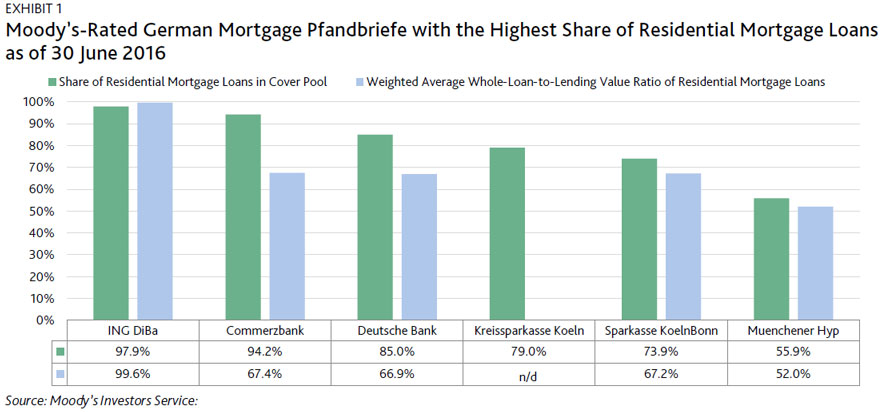Moody’s says last Tuesday, German stock exchange gazette Börsen-Zeitung reported that Germany’s Ministry of Finance had proposed a draft law aimed at tightening residential mortgage lending market regulations. Once enacted, German Financial Services Authority BaFin would be authorised to tighten residential mortgage loan origination criteria to prevent house prices from overheating. This would be credit positive for mortgage Pfandbriefe (covered bonds) and residential mortgage-backed securities (RMBS) because it would reduce the risk of households taking on excessive debt during times of inflated house prices.
The proposal comprises four components: a maximum loan-to-value (LTV) ratio, a minimum loan amortisation requirement, a maximum debt-service-to-income (DSTI) ratio and a maximum debt-to-income (DTI) ratio. The finance ministry’s proposal follows the German Financial Stability Committee’s 2015 recommendation to the German government to develop instruments to regulate residential mortgage loan origination.
The government’s proposal would only affect newly originated residential mortgage loans because of a grandfathering rule. Therefore, the credit strength of covered bond programmes and RMBS would improve over time, particularly by reducing borrower default, where a maximum LTV ratio will fall below currently LTV ratios.
Exhibit 1 provides an overview of Moody’s-rated German mortgage Pfandbriefe in which the residential mortgage loan portion exceeded 50% of total cover pool assets as of 30 June 2016. Covered bondholders of ING DiBa’s mortgage Pfandbriefe would benefit the most from a maximum LTV ratio because its cover pool has the highest share of residential mortgage cover assets (97.9%) and the highest weighted average whole-loan-to-lending-value5 ratio (99.6%). Based on lending values, 32.2% of ING DiBa’s residential mortgage cover assets have a whole-loan-to-value ratio above 100%.
 The whole-loan-to-value ratio is not only an important driver of the probability of borrower loan defaults, but also of recoveries following a borrower’s default. If the BaFin were to set the maximum loan-to-lending value ratio above 60%, Pfandbriefe would not benefit from improved recoveries following borrower default. This is because under the Pfandbrief Act covered bonds may only be issued against loans backed by up to 60% of the property’s lending value. However, the Pfandbrief Act does not limit how much borrowers can borrow against a property. The same applies to the typical eligibility criteria of an RMBS transaction. Therefore, and because lending to residential borrowers has steadily increased since 2010 (see Exhibit 2), a maximum DTI ratio would be credit positive for mortgage Pfandbriefe and German RMBS. This is particularly applicable in the current low interest rate environment, where borrowers’ affordability for large loans has substantially improved.
The whole-loan-to-value ratio is not only an important driver of the probability of borrower loan defaults, but also of recoveries following a borrower’s default. If the BaFin were to set the maximum loan-to-lending value ratio above 60%, Pfandbriefe would not benefit from improved recoveries following borrower default. This is because under the Pfandbrief Act covered bonds may only be issued against loans backed by up to 60% of the property’s lending value. However, the Pfandbrief Act does not limit how much borrowers can borrow against a property. The same applies to the typical eligibility criteria of an RMBS transaction. Therefore, and because lending to residential borrowers has steadily increased since 2010 (see Exhibit 2), a maximum DTI ratio would be credit positive for mortgage Pfandbriefe and German RMBS. This is particularly applicable in the current low interest rate environment, where borrowers’ affordability for large loans has substantially improved.

